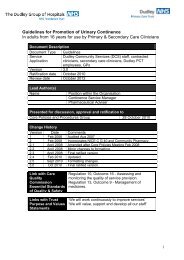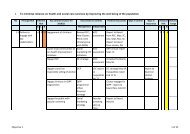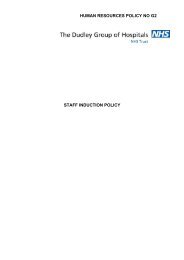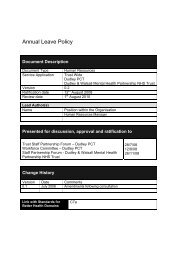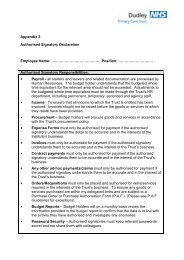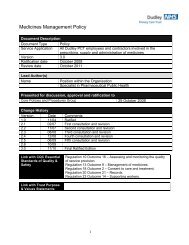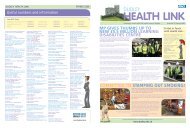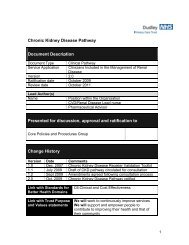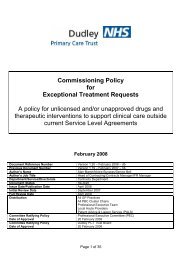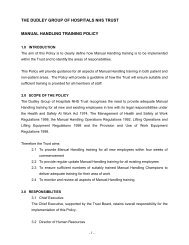Dudley Strategy for Tackling Health Inequalities 2010-15
Dudley Strategy for Tackling Health Inequalities 2010-15
Dudley Strategy for Tackling Health Inequalities 2010-15
- No tags were found...
You also want an ePaper? Increase the reach of your titles
YUMPU automatically turns print PDFs into web optimized ePapers that Google loves.
9. KEY RECOMMENDATIONSThe recommendations below have been chosen as the high priority actions that needto be addressed by a range of partners if we are to tackle the gap in healthinequalities in <strong>Dudley</strong>. They reflect the strategic aims of the strategy and provide anindication of the timescale and outcomes that will be achieved. Theserecommendations are also reflected in a high level action plan which will beimplemented and reported against by the nominated lead agency. A high levelper<strong>for</strong>mance monitoring framework has been developed to show progress againstsome of the key indicators used to measure health inequalities.The detailed delivery plans <strong>for</strong> the key priority disease areas can be found in theappendices. These have been selected <strong>for</strong> action as having the greatest impact onreducing health inequalities in <strong>Dudley</strong> and they can be found as action plans inAppendix 2 on page 219..LEADERSHIP AND PARTNERSHIP1. Strengthen leadership <strong>for</strong> health improvement and health inequalities acrossthe partnership and particularly within the Local Authority, <strong>Dudley</strong> and WalsallMental <strong>Health</strong> Partnership Trust and Acute Trust and ensure the involvementof GP Commissioning Consortia when they become established. This will beachieved through the establishment of a new <strong>Health</strong> and Wellbeing Board.GIVE EVERY CHILD THE BEST START IN LIFE2. Improve data systems across health and <strong>Dudley</strong> MBC to allow extraction ofpopulation level analyses of developmental progress of children under 5 in<strong>Dudley</strong>3. Develop further the existing parenting programme databases to reportethnicity on fidelity to programmes and outcomes of interventions in eligiblegroups.4. Consider investment profile in early years, school and adolescent programmesto examine <strong>for</strong> any scope <strong>for</strong> disinvestment and re-investment in evidencebasedearly years programmes.5. Channel any resources released from other areas of child health investmentinto the introduction of a Family <strong>Health</strong> Partnership programme with definedeligibility criteria and clear means of auditing outcomes.6. Continue implementation of <strong>Dudley</strong>‟s Parenting and Family Learning <strong>Strategy</strong>,with full tracking of adherence to eligibility criteria and outcomes <strong>for</strong> <strong>for</strong>malparenting programmes.7. Develop more <strong>for</strong>mal integrated working between the <strong>Dudley</strong> CommunityServices <strong>Health</strong> Visiting Service, the <strong>Dudley</strong> Group of Hospitals midwiferyservice and children‟s centres in <strong>Dudley</strong>, particularly between children‟s198




